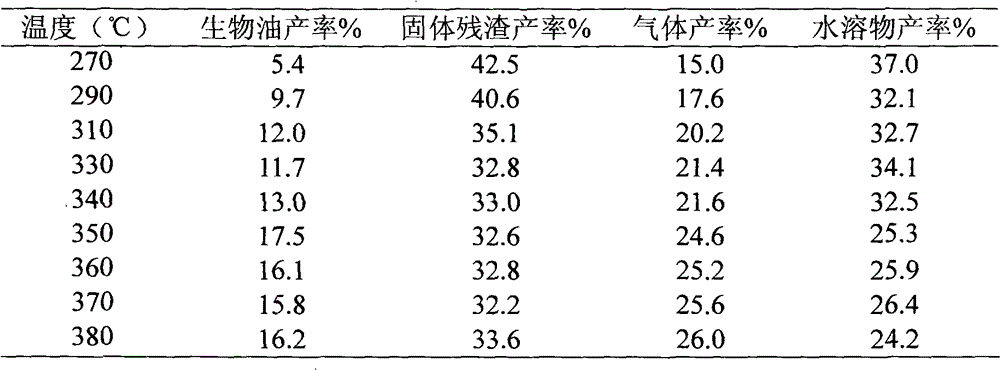Method for preparing bio-oil by treating duckweed biomass by using hydrothermal method
A technology of bio-oil and hydrothermal method, which is applied in the preparation of liquid hydrocarbon mixtures and the petroleum industry, can solve the problems of lack of research and achieve the effects of rapid growth, environmental protection and cost saving
- Summary
- Abstract
- Description
- Claims
- Application Information
AI Technical Summary
Problems solved by technology
Method used
Image
Examples
Embodiment 1
[0026] The dried duckweed is pulverized in a pulverizer to obtain fine duckweed particles. Weigh 2.5g of the treated duckweed, put it in a 25ml autoclave, add 16.9ml of water, without catalyst, and seal it. Put the autoclave into the molten salt, control the temperature at 270°C, and the duration is 60min. After the reaction is completed, quickly cool with water, open the reactor, and collect the mixture in the reactor. The reaction mixture was extracted with an organic solvent, separated and filtered to obtain an organic phase, and the organic solvent was removed by rotary evaporation to obtain bio-oil with a bio-oil yield of 5.4%.
Embodiment 2
[0028] The dried duckweed is pulverized in a pulverizer to obtain fine duckweed particles. Weigh 2.5g of the treated duckweed, put it in a 25ml autoclave, add 15.1ml of water, without catalyst, and seal it. Put the autoclave into the molten salt, control the temperature at 290°C, and the duration is 60min. After the reaction is completed, quickly cool with water, open the reactor, and collect the mixture in the reactor. The reaction mixture was extracted with an organic solvent, separated and filtered to obtain an organic phase, and the organic solvent was removed by rotary evaporation to obtain bio-oil with a bio-oil yield of 9.7%.
Embodiment 3
[0030] The dried duckweed is pulverized in a pulverizer to obtain fine duckweed particles. Weigh 2.5g of the treated duckweed, put it in a 25ml autoclave, add 14.1ml of water, without catalyst, and seal it. Put the autoclave into the molten salt, control the temperature at 310°C, and the duration is 60min. After the reaction is completed, quickly cool with water, open the reactor, and collect the mixture in the reactor. The reaction mixture was extracted with an organic solvent, separated and filtered to obtain an organic phase, and the organic solvent was removed by rotary evaporation to obtain bio-oil with a bio-oil yield of 12.0%.
PUM
| Property | Measurement | Unit |
|---|---|---|
| heating value | aaaaa | aaaaa |
| particle size | aaaaa | aaaaa |
Abstract
Description
Claims
Application Information
 Login to View More
Login to View More - R&D
- Intellectual Property
- Life Sciences
- Materials
- Tech Scout
- Unparalleled Data Quality
- Higher Quality Content
- 60% Fewer Hallucinations
Browse by: Latest US Patents, China's latest patents, Technical Efficacy Thesaurus, Application Domain, Technology Topic, Popular Technical Reports.
© 2025 PatSnap. All rights reserved.Legal|Privacy policy|Modern Slavery Act Transparency Statement|Sitemap|About US| Contact US: help@patsnap.com



